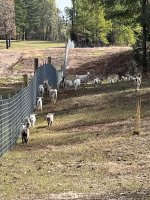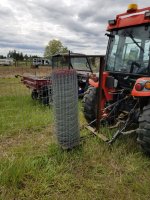EddieWalker
Epic Contributor
The 2x4 horse fence is heavy. VERY HEAVY!!! I didn't want to spend the money on the proper tool for unrolling it if I didn't have to. After looking at what I already own, I figured out that I can stand my hay spears up on the tips of my pallet forks, and hold it together with a chain and ratchet. Then I cut a plywood disk for the wire to spin on and a 2 inch pipe so the spear didn't get caught on the inside of the fencing.
I staple the fence to the wood post with barbed staples. Then I drive the backhoe backwards to unroll it. Trial and error taught me to only unroll one roll at a time before stretching it and stapling it to a wood post.
I use two come-alongs to stretch it. The strap one is super long and it allows me to find something to anchor it to up high on the backhoe. The cable one needs a chain, it' short, but more powerful, and it goes on the bottom where I can attach it to the frame of the pallet forks.


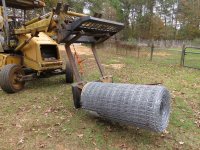
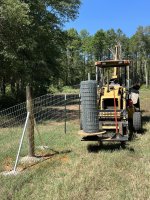
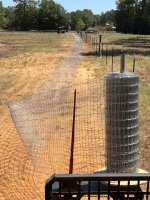
I tried tightening the wire by driving backwards, but I would either spin my tires and not get it very tight, or I would damage the wire and have to cut that section out. I did have to lower the outriggers to stop from pulling the backhoe when tightening it.
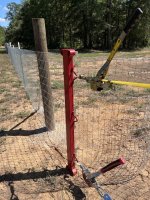

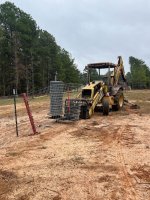
At first I tried screwing, and then bolting a pair of 2x6's together to pull the wire on the fencing around my dog yard, but that would slip, break apart, or wear out. So for this fence, I bought a 4 foot Stretcher Bar from Kencove that worked great!!
https://kencove.com/products/detail/stretcher-bar/tsc4
The thing I hate the most is connecting each roll together. I opted from crimps because they last forever. I don't trust any of the other types of connectors, and tying fencing is the worse thing ever!! The crimps work great, it's just painful to do all 13 lines every 200 feet.

Once the wire was tight, I stapled it to the posts and moved on to the next roll. Once I finished the entire run, I would start tying the fence to the the T-posts. As of right now, I have almost every other T post tied. Its slow, painful, and not my favorite thing to do, but I'll get there eventually.
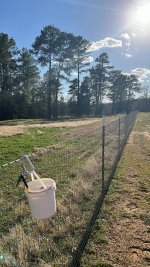
In the video, you can see my neighbors fence. When he hired the crew to install it, they just went as close to the trees as they could. One of the motivators in starting this project was a survey crew was working on the Natural Gas Pipeline on my neighbors land. They wanted permission to cross my land to get in and out, and just do their job. I said sure, and asked if they could mark the corners of the property while they where there. They agreed, and I got that done for free, and it was a win-win for everyone. I knew kind of where the corners where, but even with a metal detector, I couldn't find those pins. Fortunately, they where still there, and they found them easily. I was off by a good ways, and my neighbor was shocked at how far his fence was into his land. He is going to have a crew remove it one of these days. The best thing about my neighbor is that he said it was fine to take out every tree I wanted to remove that was on his land. The more I took out, the happier he would be!!!! More work for me, but also a huge benefit for clearing back his trees so they wouldn't damage my fence. He's really good at keeping everything mowed too.
I staple the fence to the wood post with barbed staples. Then I drive the backhoe backwards to unroll it. Trial and error taught me to only unroll one roll at a time before stretching it and stapling it to a wood post.
I use two come-alongs to stretch it. The strap one is super long and it allows me to find something to anchor it to up high on the backhoe. The cable one needs a chain, it' short, but more powerful, and it goes on the bottom where I can attach it to the frame of the pallet forks.





I tried tightening the wire by driving backwards, but I would either spin my tires and not get it very tight, or I would damage the wire and have to cut that section out. I did have to lower the outriggers to stop from pulling the backhoe when tightening it.



At first I tried screwing, and then bolting a pair of 2x6's together to pull the wire on the fencing around my dog yard, but that would slip, break apart, or wear out. So for this fence, I bought a 4 foot Stretcher Bar from Kencove that worked great!!
https://kencove.com/products/detail/stretcher-bar/tsc4
The thing I hate the most is connecting each roll together. I opted from crimps because they last forever. I don't trust any of the other types of connectors, and tying fencing is the worse thing ever!! The crimps work great, it's just painful to do all 13 lines every 200 feet.

Once the wire was tight, I stapled it to the posts and moved on to the next roll. Once I finished the entire run, I would start tying the fence to the the T-posts. As of right now, I have almost every other T post tied. Its slow, painful, and not my favorite thing to do, but I'll get there eventually.

In the video, you can see my neighbors fence. When he hired the crew to install it, they just went as close to the trees as they could. One of the motivators in starting this project was a survey crew was working on the Natural Gas Pipeline on my neighbors land. They wanted permission to cross my land to get in and out, and just do their job. I said sure, and asked if they could mark the corners of the property while they where there. They agreed, and I got that done for free, and it was a win-win for everyone. I knew kind of where the corners where, but even with a metal detector, I couldn't find those pins. Fortunately, they where still there, and they found them easily. I was off by a good ways, and my neighbor was shocked at how far his fence was into his land. He is going to have a crew remove it one of these days. The best thing about my neighbor is that he said it was fine to take out every tree I wanted to remove that was on his land. The more I took out, the happier he would be!!!! More work for me, but also a huge benefit for clearing back his trees so they wouldn't damage my fence. He's really good at keeping everything mowed too.
Last edited:
